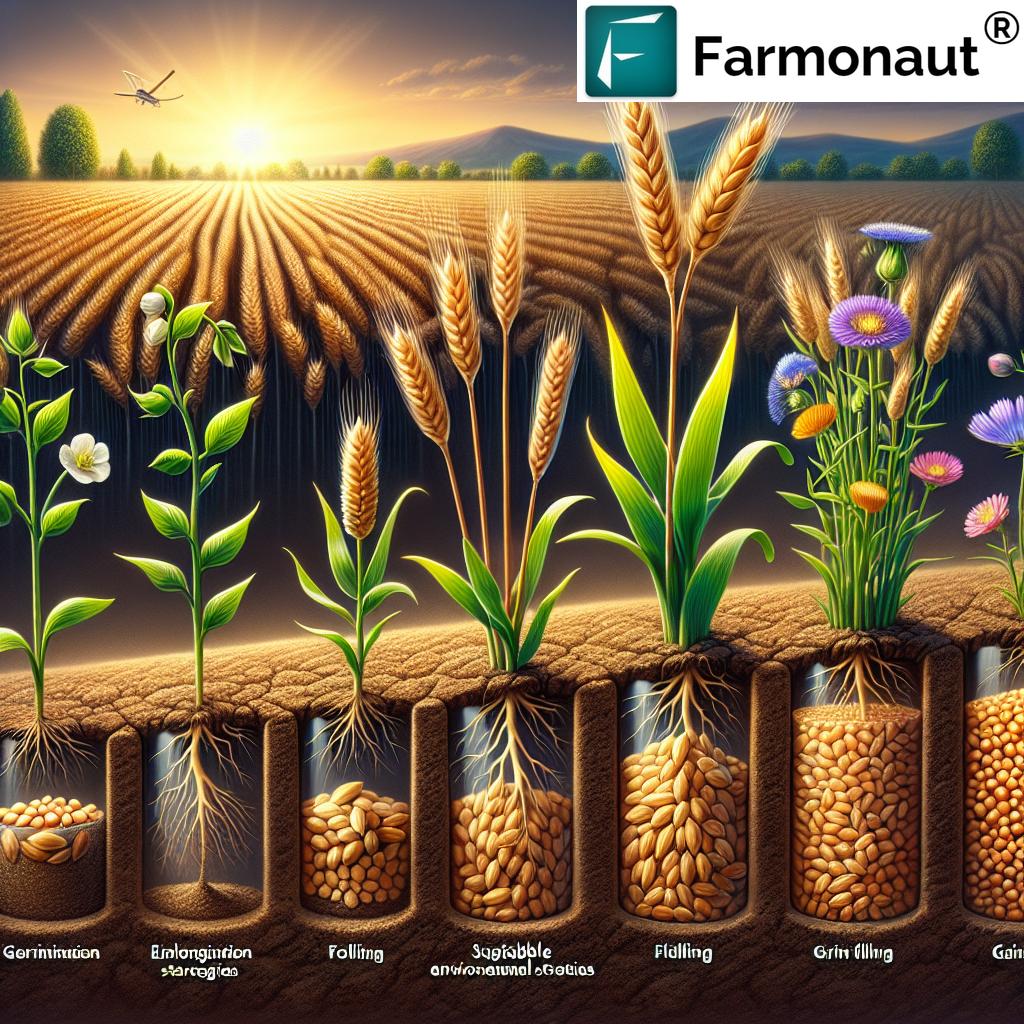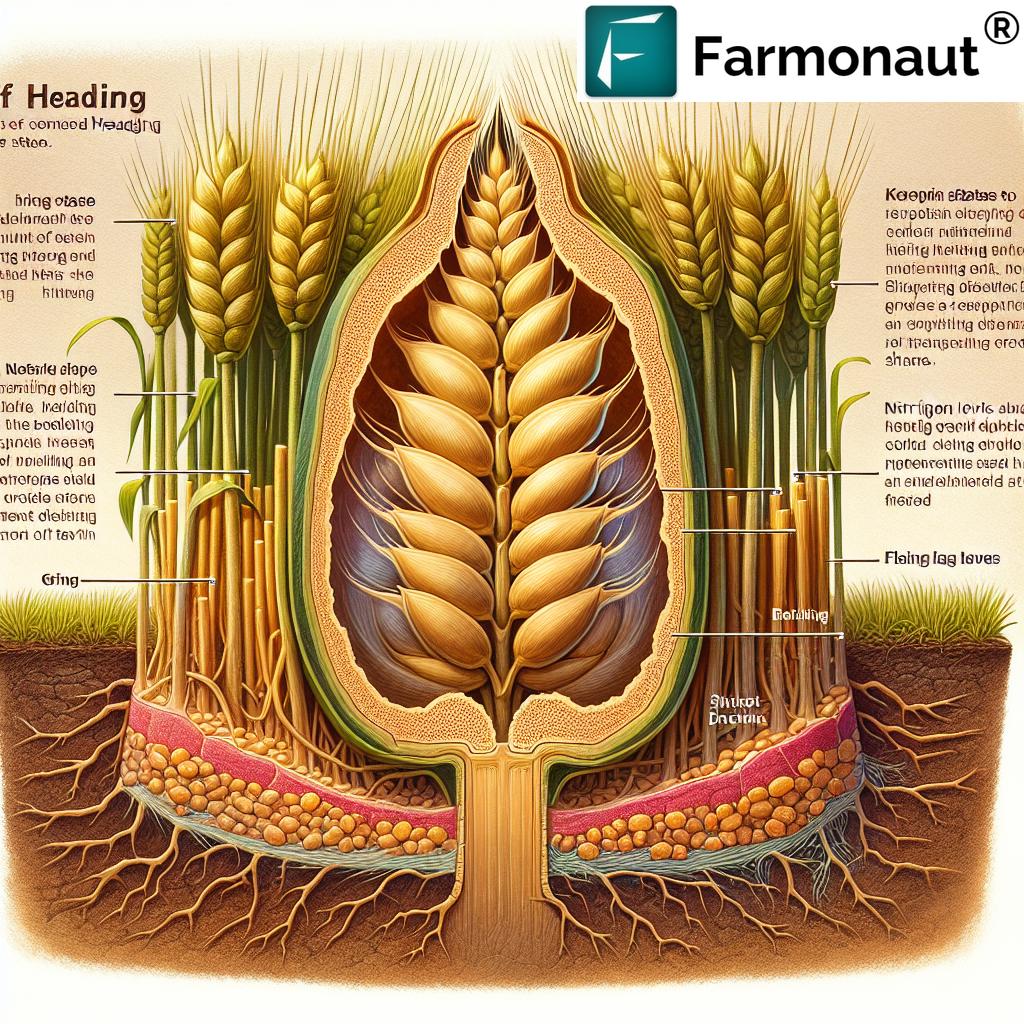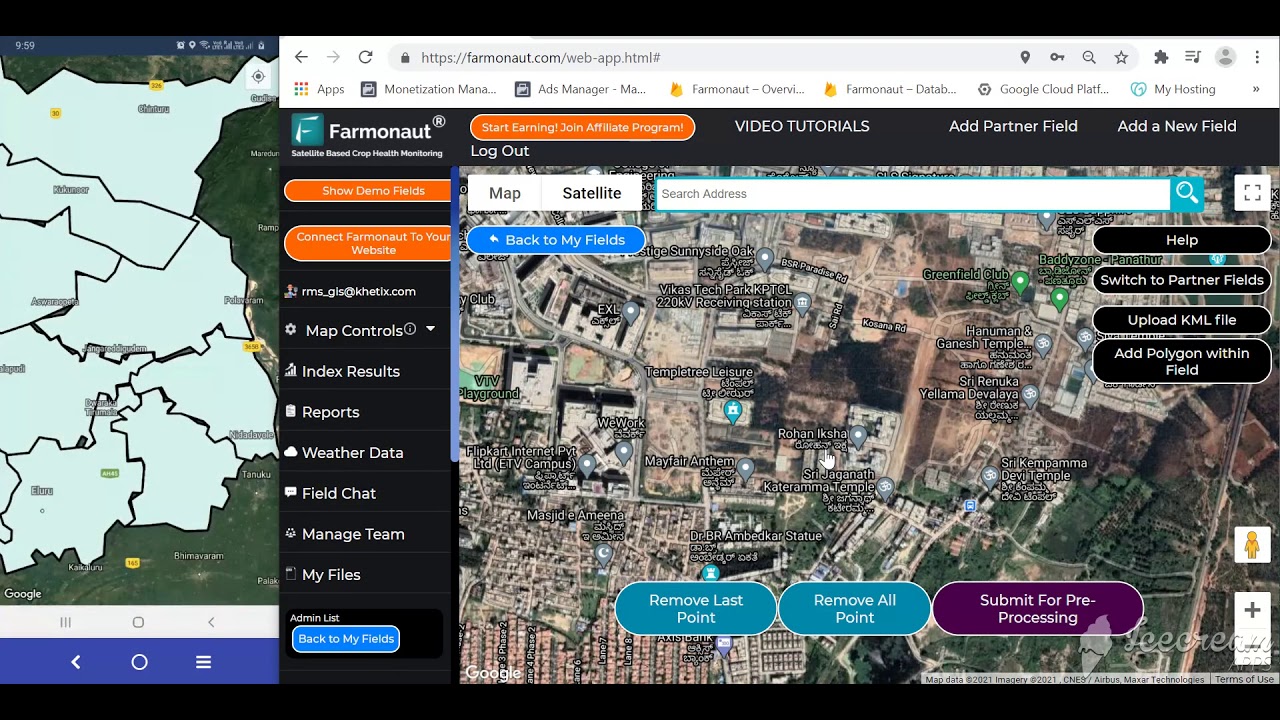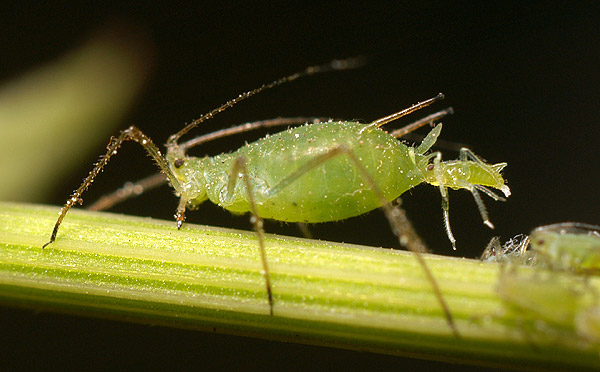Table of Contents
- Introduction: Wheat Growth Stages & Their Importance
- Trivia: Power Facts
- 1. Germination and Seedling Establishment
- 2. Tillering
- 3. Wheat Stem Elongation Phase
- 4. Wheat Booting and Heading
- 5. Flowering (Anthesis): The Critical Stage
- 6. Grain Filling in Wheat and Ripening
- 7. Wheat Maturity and Harvest Time
- Wheat Growth Stages and Management Practices Table
- Precision Farm Management with Farmonaut
- Trivia: Nitrogen & Wheat Yield
- Frequently Asked Questions (FAQ)
- Conclusion: Achieving Optimal Wheat Yield
- Farmonaut Apps, API, & Subscription
Stages of Growing Wheat: Essential Guide to Optimal Yield
“Wheat reaches its flowering stage around 60-70 days after sowing, crucial for determining final grain yield.”
Wheat cultivation is a complex, multifaceted process that requires a deep understanding of the plant’s developmental phases. Each stage in the wheat growth cycle—from germination through harvest—is critical for achieving optimal wheat yield. By monitoring and tailoring management practices for each phase, farmers can improve grain quality, minimize losses, and boost overall productivity. In this essential guide, we systematically explore all wheat development stages with actionable insights, best practices, and high-tech monitoring solutions.
Why Understanding Wheat Growth Stages is Essential
- Enables targeted management (irrigation, fertilization, pest control) at critical times
- Supports monitoring and adaptation to environmental conditions
- Improves final grain yield and quality
- Facilitates precision farming and resource efficiency
What are the Main Wheat Growth Stages?
The journey of wheat from seeds to harvest includes seven distinct stages:
- Germination and Seedling Establishment
- Tillering
- Wheat Stem Elongation Phase
- Wheat Booting and Heading
- Flowering (Anthesis)
- Grain Filling in Wheat and Ripening
- Wheat Maturity and Harvest Time
Let’s explore each of these stages in detail, with examples, practical advice, and cutting-edge monitoring recommendations.
1. Wheat Germination and Seedling Establishment
The Beginning of the Wheat Growth Stages
The first stage in the wheat life cycle begins as wheat seeds are sown into the soil. Germination is triggered when seeds absorb water, swell, and eventually sprout.
- Optimal soil temperatures: 50°F to 86°F (10°C to 30°C)
- Typical duration: 7 to 10 days under favorable conditions
- Seedlings emerge when stored energy is utilized until the first true leaf unfurls
Monitoring soil conditions at this stage is critical, especially for moisture levels and temperature, as these influence germination rate and seedling establishment.
Key tip: Uniform sowing and adequate soil moisture content foster even seedlings and reduce patchy crop stands, which can negatively affect final yield.
Best Management Practices During Germination
- Ensure optimal soil preparation: Loose, non-compacted soil with even texture
- Use high-quality seeds with high vigor and germination rates
- Apply pre-sowing irrigation if soil moisture is low
- Monitor soil temperature before and after sowing for optimal emergence
- Use Farmonaut’s crop health monitoring for real-time seedling establishment feedback
Common Challenges & Solutions
- Delayed emergence: Could be due to low soil temperatures or crusted soils. Consider adjusting planting time or conducting light surface irrigation.
- Uneven stands: Use only certified, disease-free seeds and ensure consistent soil moisture.
2. Tillering: Building the Foundation for High Yield
The Stage of Plant Multiplication
Following germination, wheat enters the
tillering stage, where multiple stems known as tillers emerge from the base. This tillering phase generally
begins when the plant has 3 to 4 leaves and
lasts for 30 to 50 days.
Each tiller has the potential to produce a grain head, amplifying the plant’s productive capacity. The
number of tillers established directly links to the final number of grain heads—and thus, overall yield potential.
- Nitrogen application: Critical for stimulating and supporting vigorous tiller production
- Soil moisture: Adequate water supply boosts tiller survival—drought stress during tillering can
reduce yield - Pest management: Early intervention protects vulnerable young shoots
Observation: A robust tillering stage is vital—weak performance here can rarely be compensated later. Farmonaut
users can monitor tiller density and soil nitrogen status via satellite-based data, enabling timely correctives.
3. Wheat Stem Elongation Phase
From Foundation to Vertical Growth
Next, our wheat crop enters the stem elongation phase, a rapid growth period during which the
main stem and developed tillers begin growing taller. The first node becomes
visible above the soil surface, marking the official start of this stage.
Duration: The wheat stem elongation phase typically lasts 10 to 20 days.
- Growth rate accelerates, with active cell division and elongation
- Foundation for head development established— number of grain sites is being determined
- Key Management Practices: Continue irrigation to maintain steady soil moisture, apply fungicides if weather is conducive to disease
Farmonaut users can visually track plant height and detect
development lags using satellite NDVI maps, ensuring prompt intervention for uniform crop stands.
4. Wheat Booting and Heading
The Approach to Grain Formation
The next pivotal milestone in wheat growth stages is the
booting stage—when the developing head is enclosed within the sheath of the flag leaf, giving the stem a distinctive swollen appearance at the top.
Shortly after booting, the wheat head emerges in a process called heading.
Heading typically begins 6 to 8 weeks after crop emergence, marking the visible transition to the reproductive phase.
- This stage is critical for determining the final grain number.
- Wheat is most susceptible to heat and moisture stress, which can severely reduce head formation and final grain yield.
- Fertilizer application at this stage can support optimal grain development, especially if deficiencies are present.
Insider tip:
Sprinkler irrigation or anti-stress foliar sprays may be considered to mitigate heat or drought impacts during heading, ensuring full head emergence and maximizing grain site potential.
Monitoring and Management in Booting & Heading
- Monitor for rusts and foliar diseases: Early intervention prevents spikelet sterility and grain number reductions
- Field scouting: Check for head emergence uniformity—delays can signal hidden stresses
- Farmonaut platform enables predictive stress alerts: Our AI tools analyze crop health using satellite data to signal bottlenecks before visible symptoms appear, letting farmers implement corrective action quickly
Integrate Farmonaut’s satellite-powered wheat growth monitoring with your own system via our robust API.
See Farmonaut API Developer Docs
5. Flowering (Anthesis): The Critical Stage
Flowering, or anthesis, is the brief yet vital period wherein pollination occurs and the final number of fertile florets per head is determined. This stage typically lasts 4 to 5 days and is deeply sensitive to environmental extremes.
- Optimal temperatures: 64°F to 75°F (18°C to 24°C)
- Heat, drought, and high humidity can all reduce flower fertility, impacting overall grain number and final yield.
- This stage marks the transition from vegetative to reproductive growth phases.
Why is Flowering a Make-or-Break For Yield? | Any significant stress (such as hot, dry winds) during anthesis can shrink the number of kernels by causing sterility. Thus, monitoring wheat crop for optimal results—especially environmental alerts—is essential here.
Best Practices During Flowering (Anthesis)
- Continue gentle irrigation (avoid waterlogging)
- Pest and disease scouting (especially for Fusarium head blight)
- Apply micronutrient sprays if deficiencies (e.g. boron, zinc) detected via satellite crop health analytics
- Monitor local weather—with Farmonaut’s AI-based weather forecast tools—to pre-empt heat spells or sudden showers
“Optimal nitrogen application during the tillering stage can boost wheat yields by up to 20%.”
6. Grain Filling in Wheat and Ripening
Where Yield and Quality Take Shape
Grain filling in wheat occurs after flowering, lasting 20 to 30 days, and is a decisive phase for kernel weight, size, and protein content.
- Kernels accumulate starch and proteins, changing texture from watery to milky, doughy, and finally hard
- Photosynthetic rate is at its peak—healthy green leaves are vital
- Any leaf damage (e.g. from diseases or pests) will reduce grain filling and impact yield/quality
- Optimal irrigation: Consistent soil moisture, especially during early filling, is crucial; drought now will cause shriveled, light kernels
- Start checking kernel moisture content during late filling to time harvest for maximum quality
Did you know?
Aim to maintain leaf health and soil moisture until the lower stem leaves start to senesce—this maximizes both yield and grain protein levels.
7. Wheat Maturity and Harvest Time
The Final Stage: Reaping the Reward
The wheat maturity stage marks the end of the crop cycle, with kernels hard, dry, and ready for harvest.
- Sign of maturity: Plant’s green tissues turn straw-colored
- Grain moisture: Drops to levels suitable for harvesting and storage (typically 12-13%)
- Delaying harvest: Can lead to grain shattering, sprouting, and quality losses
Tips for Optimal Wheat Maturity and Harvest Time
- Use Farmonaut’s near-real-time satellite alerts to optimize harvest window, minimize weather risks, and maximize grain quality.
- Monitor kernel moisture using field tests or digital moisture meters.
- Prep storage and logistics in advance to prevent post-harvest loss.
Wheat Growth Stages and Management Practices Table
| Growth Stage | Estimated Duration (days) | Critical Management Practices | Optimal Monitoring Parameters | Expected Yield Impact |
|---|---|---|---|---|
| Germination & Seedling Establishment | 7–10 | Seed selection, soil preparation, pre-sowing irrigation, initial pest control | Soil moisture 55%–75%, uniform emergence, seedling density | High |
| Tillering | 30–50 | Nitrogen application, irrigation, early weed and pest management | Tiller count per plant, early plant height (cm), nitrogen levels | High |
| Stem Elongation | 10–20 | Steady irrigation, fungicide spray (if needed), monitor nutrient status | Plant height (cm), foliar health, soil moisture | Medium |
| Booting & Heading | 10–14 | Disease and pest check, micronutrient spray, avoid stress (irrigate if dry) | Head emergence %, flag leaf condition, heat/moisture stress | High |
| Flowering (Anthesis) | 4–5 | Pest/fungal control, consistent irrigation, micronutrient correction | Floret fertility, field temperature (°C), humidity levels | Critical |
| Grain Filling & Ripening | 20–30 | Maintain leaf health, final irrigation, harvest preparation | Leaf greenness, grain moisture (%), pest/disease scouting | High |
| Maturity & Harvest | 7–10 | Harvest timing, grain moisture check, logistics management | Kernel moisture <13%, straw/yellowing, equipment prep | High |
Precision Management Practices for Wheat Cultivation with Farmonaut
At Farmonaut, we understand the vital importance of tailoring management to each wheat growth stage. That’s why we offer a suite of advanced tools and apps for monitoring wheat crop for optimal results:
- Satellite-Based Crop Health Monitoring: We enable farmers to visualize NDVI changes, soil moisture variations, and identify stress at every stage, from sowing to maturity
- AI-Based Jeevn Advisory: Real-time, data-driven crop care recommendations—whether you’re at germination, tillering, or harvest
- Blockchain Traceability: Ensures your wheat’s journey is transparent from seed to silo, adding value and trust to your produce
- Fleet & Resource Management: Effortlessly track field teams, equipment, and resources, minimizing waste during crucial operations like irrigation, nutrient spraying, and harvest runs
- Mobile & Web Access: Get these insights yourself—anywhere, anytime, on Android, iOS, or web platform
Frequently Asked Questions (FAQ)
1. What are the major wheat growth stages?
Answer: The major wheat growth stages include germination and seedling establishment, tillering, stem elongation, booting, heading, flowering (anthesis), grain filling, and maturity/harvest. Each stage is critical in the crop’s life cycle and influences final yield and quality.
2. How can I estimate the optimal wheat harvest time?
Answer: Wheat is ready for harvest when most plants turn straw-yellow and kernel moisture drops to 12-13%. Use moisture meters or field test methods, and monitor weather. Delaying harvest increases shattering and decreases grain quality.
3. Why is nitrogen application during the tillering phase crucial in wheat cultivation?
Answer: Nitrogen applied during the tillering stage maximizes tiller growth, head number, and thus, the potential grain yield. It can boost wheat yields by up to 20%, but over-application must be avoided.
4. Are there digital tools to monitor wheat development stages?
Answer: Yes, solutions like Farmonaut’s crop health monitoring platform allow you to visually track crop progress, detect problems, and receive real-time advisory for every wheat growth phase.
5. How do environmental stresses at flowering and booting impact wheat yield?
Answer: Heat, drought, and diseases during flowering or booting can reduce fertile florets, cause sterility, and shrink final grain number, making stress management at these stages vital for optimal yield and quality.
Conclusion: Achieving Optimal Wheat Yield Through Stagewise Management
Understanding and carefully managing each of the wheat growth stages is the foundation for maximizing both yield and quality.
- Germination and seedling establishment set the tone for population and uniformity
- Tillering multiplies yield potential through head formation
- Stem elongation builds the plant structure for head emergence
- Booting and heading are decisive for grain site establishment
- Flowering is a critical, stress-sensitive determinant of kernel number
- Grain filling & ripening build weight and quality
- Maturity and harvest timing protect and realize your hard-earned yield
By incorporating precision farming and relentless crop monitoring—like that enabled by Farmonaut’s satellite-driven insights and AI tools—farmers can implement stage-appropriate practices, adapt to environmental stresses, and achieve optimal wheat yields season after season.
Ready to unlock the future of farming? Monitor, manage, and maximize your wheat crop—from seed to silo—with Farmonaut.






















